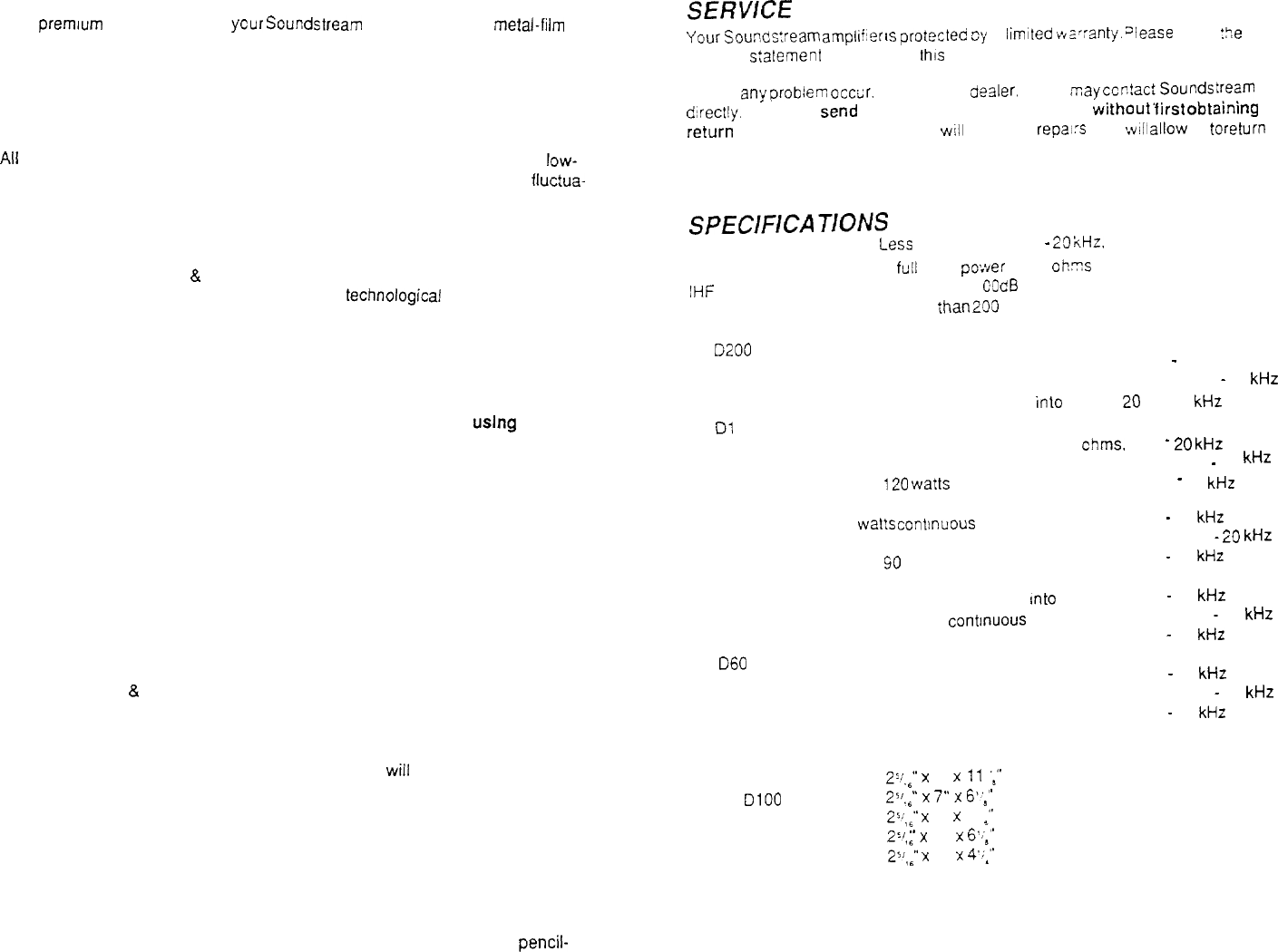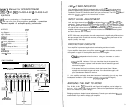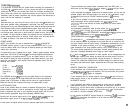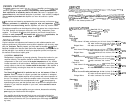
DESIGN FEATURES
Only premium parts are used in ycur
Soundstream
amplifier, such as metal-film
resistors, gold-plated input connectors, and immersrble sealed potentiometers.
Each output device is individually rated at 125 watts. The case is equipped with
generous heat sinks, and thermal protection is provided.
Input sensitivity
is adjust-
able to match any tuner/deck -the amplifier can even be used as a power
booster.
Ail gain devices are biased by regulated active current sources, so that even
low-
frequency performance is unaffected by supply-line noise and temperature
fluctua-
lions. There is no current limiting, and the amplifiers will drive fully reactive loads.
Soundstream amplifiers can be bridged to deliver high power into a single channel.
The D200 features dual-monaural construction, with
fully
independent power
supplies. The Class-A-50
&
Class-A-40 operate in pure Class A mode for the
ultimate in sonic transparency. And despite their
technologicat
sophistication, the
Soundstream amplifiers are elegantly simple in design.
INSTALLATION
Proper installation and adjustment will reward you with reliable operation and
optimum performance. Automotive sound system installations can be tricky, espe-
cially for first-timers.
For
this reason, you may want to consider using a pro-
fessional installer who has the tools and more Importantly, the experience to
do the job right. If you decide to install your equipment yourself, we hope that
this manual will serve as a helpful guide.
LOCATION &MOUNTING
The first step in installation is thorough planning. Choose the location for your
amplifier carefully. The amplifier should be located in either the passenger
compartment or the trunk, never in the engine compartment or in any outside
location exposed to dirt and moisture. Adequate ventilation is important; allow
enough space so that air can circulate around the heat sinks. If the amplifier is
mounted vertically, mounting the heat sink fins vertically will optimize heat
dissipation.
The Class-A-50
&
Class-A-40 in particular tend to run hot because of Class A
operation. This is no cause for concern provided that ventilation is adequate.
Make sure that the installed amplifier will not interfere with normal operation of
the car. For example, if you locate the amplifier under a front seat, make sure
that it does not interfere with seat adjustment, that it
will
not be exposed by
repositioning the seat, and that the seat does not press on the amplifier when
occupied. If you install the amplifier in your trunk, make sure that it is not an
obstruction.
It is best not to locate the amplifier near your antenna, because the switching
power supply can interfere with AM reception.
Your amplifier should be mounted firmly to your car’s interior with the four
screws/washers provided. Use your amplifier as a template for making pencil-
marks where you intend to drill. (Do not operate your drill through these mount-
ing holes.)
SERWCE
your
Sounbs::eam
ampiii:er
1s
protected
sy
a
limIted
b*(Zr:anty.
?ease
read
!:e
warranty
statement
supplied with
this
manual.
Should
any
probiem
occur.
contact your
Gealer.
or you
$T:ay
ccn!act,Sounds:!eam
d;recl!y.
DO NOT
send
your amplifier to Soundstream
wlthout
flrSt
obtamlng
a
return
authorization number. This
WI/I
facilitate
repa,rs
and
W/I
allOW
US
t0
return
your unit in the shortest possible time
SPEClFlCATlONS
THD
Less
than 0.19;. 20 Hz
-
29
;tHz.
at
full
rated
po’>der
into 4
Oh75
IHF
Greater than 1
COdB
Damping
Greater
than
200
Power output
I3200
Dual channel 100
watts continuous per ch
into
4 ohms, 20 Hz 20kHz
-
120 watts continuous
per
ch into 2 ohms, 20 Hz
-
20
kHz
Bridged Mono
240 watts continuous
into
4 ohms
20
Hz -20 kHz
Dl
00
Dual channel 50
-
watts continuous per ch into 4
chms.
20 HZ
20
kHz
60 watts continuous per ch into 2 ohms, 20 Hz
-
20
kHz
Bridged Mono
-
120
watts
continuous into 4 ohms, 20 HZ 20
kHz
Class-A-50
Dual channel 25
wa!?s
continuous
per ch
into
4 ohms,
20 Hz
-
20 kHz
45 watts continuous
per
ch into 2
ohms,
20 Hz
-
20
kHz
Bridqed Mono
90
watts continuous
into
4 ohms,
20 Hz
-
20 kHz
Class-A-40
Dual channel 16
watts continuous per ch
Into
4 ohms,
20 Hz
-
20
kHz
25 watts
continuous
per
ch into 2
ohms,
20 Hz
-
20
kHz
Bridged Mono
60 watts continuous
into
4 ohms,
20 Hz
-
20
kHz
D60
Dual channel30
wafts continuous per ch
into
4 ohms.
20 Hz
-
20
kHz
45 watts continuous
perch into 2
ohms,
20 Hz
-
20
kHz
Bridged Mono
80 watts continuous
into 4 ohms,
20 Hz
-
20 kHz
Dimensions
0200
DlOO
Class-A-50
Class-A-40
D60
2’/,,”
x
7”
x
1
1
y’
21/,6(1
x
7”
x
61,~”
25/>,‘%
x
7”
x
6’
,”
2%
”
x
7”
x
6‘,,,”
25,::”
x
7”
x
4’;,”






